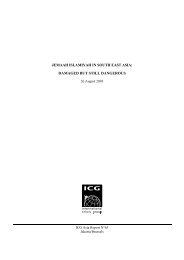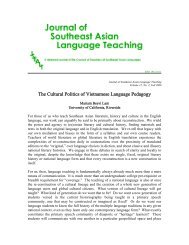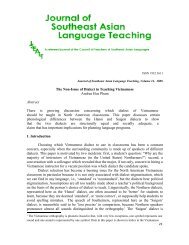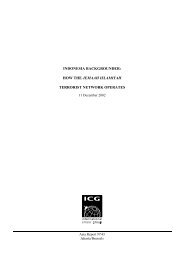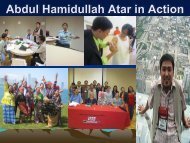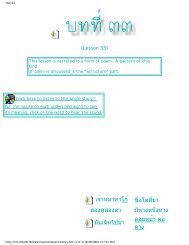Introduction - SEAsite - Northern Illinois University
Introduction - SEAsite - Northern Illinois University
Introduction - SEAsite - Northern Illinois University
Create successful ePaper yourself
Turn your PDF publications into a flip-book with our unique Google optimized e-Paper software.
Prentation Abstracts<br />
and serpents. In fact, the pre-Aryan India and Southeast Asia shared many cultural<br />
traits that were similar. Many facets of life in India and Southeast Asia looked<br />
alike. They are interwined to such a degree that sometimes it becomes difficult to<br />
differentiate between them.<br />
The present article would focus on India’s cultural contact with Laos in ancient<br />
and medieval times with special reference to literature. As far as Indian influence<br />
was concerned, Hindu and Buddhist practices came to Laos in the early centuries<br />
of present era through Chinese, Khmers and Thais. It is difficult to have an exact<br />
idea of the period of beginning of cultural contact between India and Laos due<br />
to absence of historical records. According to local tradition, a Buddhist shrine<br />
(That) was built in Laos during Asoka’s time in about middle of third century<br />
before Common Era. The Ourangkharittan chronicle mentions that That Luang of<br />
Vientiane was earlier built by a Buddhist monk Phra Chao Chanthaburi Pasithisak<br />
to keep Buddhist relic brought from Rajgir in India<br />
The prevalence of Hinduism also could be known from the numerous inscriptions<br />
found in Laos. On the top of Phou Lokan hill, a Sanskrit inscription<br />
mentions the erection of Siva linga by king Mahendravarman. Another inscription<br />
of second half of fifth century compares the King Sri-Devanika with Yudhisthira,<br />
Indra, and Dhananjay and with Indradyumna. In art and architecture, the impact<br />
of various Indian styles is clearly marked. The concept is Indian, but in the choice<br />
of pattern and other details, indigenous touch is given. The different types of Buddhist<br />
icons found in Laos were in conformity with Indian canons.<br />
Sanskrit and Pali made deep inroads into the script, language and literature<br />
of Laos. Majority of the Lao inscriptions had been in Sanskrit. The wide prevalence<br />
of Sanskrit influenced immensely the classical Lao script, language and literature.<br />
Lao script was introduced by King Rama Kampheng of Sukhodaya in 1283<br />
C.E., which marked the common origin of Thai and Lao alphabets. In the same<br />
year, Pali scriptures from Sri Lanka were introduced resulting in greater influence<br />
of Pali. One type of Lao script known as Toua-Lam is considered sacred and it is<br />
used for transcribing Pali. In Lao language, there are about sixty percent of words<br />
having Sanskrit and Pali origin. There are many Lao words having Indian origin<br />
like: Kumara (Kumara), Pativat (Prativada), Pathet (Pradesh), Prom (Brahma),<br />
Pranam (Pranam), Rusi (Rsi), Shanti (Santi), Sri (Sri), Sut (Sutra), Setthi (Sresthi),<br />
Youvatnari (Yuvanari), Sabha (Sabha), Champa (Campa), Nang Mekhala (Mani<br />
Mekhala), Nang Thorani (Devi Dharani), Praya Nak (Nagaraja) etc. The true classical<br />
Lao poetry is formed by translation of Indian poems, and Lao verses follow<br />
the metrics of Indian prosody. In folk songs, dramas and theatres, themes from<br />
Indian literature are in abundance. The Lao folklore had been influenced by Indian<br />
themes. Development of religious song of Buddhist monks encouraged many stories<br />
becoming popular in both prose and poetry. In the classical Lao dance, one can<br />
find gestures and movements showing strong influence of various Indian dance<br />
forms.<br />
The Ramayana is very popular in Laos. The country was earlier known as<br />
Lava, the son of Rama. The stories of Rama or Phra Lak Phra Lam with its fundamental<br />
human value and social idea has contributed to the cultural life of people.<br />
The Lao have adopted the stories of Ramayana as if it had happened in Laos.<br />
Names, titles and geographical settings were given local colour. The majority of<br />
Lao stories were derived from the Pancatantra. It was translated into Lao language<br />
by Phra Samgharaja Vixula Mahaviharathipati in 1507 C.E. of Wat Vixula Mahavihan.<br />
The Pancatantra stories written by Visnu Sarma of Orissa became very<br />
popular in Laos. The Lao version consisted of five Pakon (Prakarana); Nanda,<br />
Manduka, Pisaca, Sakuna and Samgha.<br />
Indian culture was diffused through the autochthonous societies of Laos and<br />
other areas of Southeast Asia, whose material base was of such a standard that it<br />
could assimilate elements of that culture. The people of the region had knowledge<br />
of metal industry, long-established contact with outside world, acquaintance with<br />
marine technology and a developed agriculture. An attempt to assign greater role<br />
either to India or to Southeast Asia would be futile. Moreover, giving importance<br />
to terminologies like Indic, Indianization, Classical or Indigenization would result<br />
into semantic controversy. The whole process of Indian cultural influence was<br />
interaction between culture of India and Southeast Asia.<br />
Priwan Nanongkham<br />
Khaen Repertories: The Developments of Lao Traditional<br />
Music in Northeast Thailand<br />
Kent State <strong>University</strong>, Ohio<br />
The khaen, a bamboo free-reed mouth organ is the predominant musical instrument<br />
among Lao people in mainland Southeast Asia. There is limited evidence<br />
of its origin but it appears to have been invented and developed over thousands<br />
of years in Lao culture. Due perhaps to its long history, the khaen is considered,<br />
among the other Lao instruments to have the richest musical literature. In terms of<br />
instrumental music, the music of the khaen is considered the “mother” of the Lao<br />
music. Its repertories are the basis of the other Lao musical instruments. Most of<br />
all, the khaen is a musical symbol of both Lao people in the Isan region (Northeast<br />
Thailand) and modern-day Laos.<br />
Khaen music is based on aural tradition. The repertory is called lai, meaning<br />
pieces of music, modes, and keys, which can be classified into several categories.<br />
However, the highest art of the khaen repertory is improvisation based on a certain<br />
scale and modes. Khaen music is based on a five-tone collection (pentatonic scale)<br />
which can be divided into two kinds of modes: thang sun and thang yao according<br />
to its diatonic tuning system. Each mode can be played in three different keys.<br />
As a result, there are six sets of five-tone paths that can be played on the khaen.<br />
The improvisation on these six paths comprises the primary repertories of khaen<br />
music. The last developmental stage of indigenous khaen music is considered to<br />
have occurred during the second and third quarters of the twentieth century. The<br />
six primary repertories reached the pinnacle of high technique and virtuosity as<br />
well as improvisation. They became the most serious listening pieces before the<br />
decline of Lao traditional music due to the impact of westernization and mass<br />
media during the last quarter of the twentieth century.<br />
Lao people sing lam or khup-lam (vocal musics) and play the khaen in keeping<br />
with the roots of their musical heritage. Besides functioning as informal individual<br />
instrument, the play khaen also accompanies the more formal vocal musics.<br />
The development of khaen music is based on these two functions. As in most<br />
cultures in the world, vocal musics played a more significant role prior to the rise<br />
of instrumental music. In Lao culture the khup-lam accompaniment is the most<br />
influential music in the development of the khaen repertories.<br />
In northeast Thailand after World War II, a developing vocal genre began<br />
to reach its popularity. Influenced by a new-found capitalism, the lam klawn and<br />
other Isan traditional genres became “professions.” Khaen music, as an accompaniment<br />
of the lam klawn also reached the peak of its indigenous development as<br />
well before westernization impacted these traditional musics in the late twentieth<br />
century.<br />
This paper will discuss the structure of khaen music and its indigenous development<br />
of both instrumental and vocal repertories from the early to the final<br />
stages of its development. The correlation between the roles, status and repertories<br />
of the instrument and changing social conditions across time will be examined as<br />
well.<br />
Kingsavanh Pathammavong<br />
Cultural Heritage of the Lost Kingdom in the United States:<br />
The History of Laotian People in America<br />
Independent Researcher, Washington D.C.<br />
People from Asia and the Pacific region came to the United States at different<br />
times, by different routes, and for different reasons. But beyond these differences,<br />
immigrants and refugees alike share the same experiences of hardship and find<br />
great reward in their move to a new land. This is certainly true of the Laotian<br />
people who have relocated to America for the past 30 years.<br />
“Cultural Heritage of the Lost Kingdom and the United States,” is an overview<br />
of the Lao-American history. To better understand whom the Lao people<br />
are we need to explore from where their ancestors came? What happened to their<br />
society before they reached the shores of the United States of America? And how<br />
the Lao people assimilated into the American society today. To comprehend the<br />
answers to these questions, it is very crucial that their social, cultural and political<br />
history be broken down into seven periods.<br />
1. The migration from southern China<br />
2. The establishment of Lan Xang Kingdom<br />
3. The Siam annexation (1778-1893)<br />
4. The French colonization (1893-1954)<br />
5. The Last Kingdom of the Lao People (1954-1975)<br />
6. The Darkest Page in Lao History, 1975<br />
7. The establishment of the Lao-American community in the U.S. (1953 to<br />
present)<br />
Until the twenty-first century, Laos had been numbered among the undeveloped<br />
countries of the world. Democracy and sovereignty have remained in







